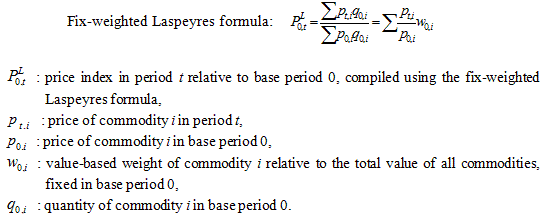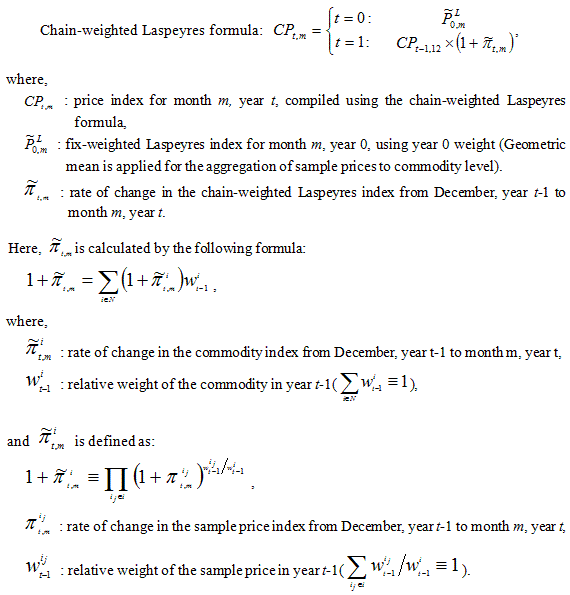Outline of the Corporate Goods Price Index (CGPI, 2010 base)
March 2015
Bank of Japan
Research and Statistics Department
1. Purpose and Application
The Corporate Goods Price Index (CGPI) measures the price developments of goods traded in the corporate sector. One of the purposes of the index is to grasp the supply and demand conditions of individual goods, as well as to provide material for the economic assessment and the monetary policy decision-making. Also, the CGPI is used as a deflator in calculating real values, i.e., in removing price factors from fluctuations in nominal values, such as in the estimation of the National Accounts (Cabinet Office). In addition, the CGPI is cited as a reference for the price-setting activities in the private sector.
2. Structure, Classification and Weights
Commodities are classified into three Basic grouping indexes: Producer Price Index (PPI), previously called the Domestic Corporate Goods Price Index (DCGPI), Export Price Index (EPI) and Import Price Index (IPI). The Bank of Japan (BOJ) also compiles Reference indexes in which commodities of the Basic grouping indexes are reclassified under different criteria for specific purposes or adjustments made to the sample prices (see below) of the Basic grouping indexes.
Basic grouping indexes
Producer Price Index (PPI)
For the PPI, the BOJ surveys prices of domestically-produced and domestically-traded goods in the corporate sector, mainly at the time of shipment by producers. The weights are calculated using value of transactions (which are obtained by deducting the export value of 2010 in the Trade Statistics of Japan by Ministry of Finance from total shipments of 2010 in the Census of Manufactures by Ministry of Economy, Trade and Industry). As for weights which cannot be calculated from the above sources (such as non-manufacturing products), the BOJ uses other statistics published by government agencies or industry organizations accordingly. The PPI is classified into 5 major groups and further classified into 23 groups; it is compiled including the consumption tax.
Export Price Index (EPI) & Import Price Index (IPI)
Prices of exports from Japan are surveyed for the EPI, while those of imports to Japan are used for the IPI. The indexes are published on both a yen basis and a contract currency basis. The value of exports and imports of 2010 (from the Trade Statistics of Japan by Ministry of Finance) are used for calculating the weights. The EPI and IPI are classified into 7 groups and 10 groups, respectively.
Reference indexes
Index by Stage of Demand and Use (ISDU)
This index is compiled by reclassifying the PPI excluding the consumption tax (see below), EPI and IPI in terms of commodities' stage of demand or use of goods. It is used to analyze various price developments, such as how a price change in one stage affects that in other stages.
Producer Price Index using Chain-weighted Index Formula (Chain-weighted PPI)
This index recalculates the PPI using the chain-weighted Laspeyres formula. Weights are chain-linked, which allows the weights to change annually (every December). It is compiled including the consumption tax.
Producer Price Index excluding Consumption Tax (PPI excluding consumption tax)
This index is compiled using prices excluding the consumption tax.
Prewar Base Index (PBI)
This index is compiled by rearranging the Basic grouping indexes and ISDU in consistent with the Prewar Base Index classification (which consists of the basic grouping and the special grouping by use of goods).
Standard passenger cars (for North America) & Standard passenger cars (for the rest of the world)
These indexes are compiled by recategorizing sample prices of "Standard passenger cars" in the EPI by destination.
3. Base Year for Index and Weight Calculation
The calendar year 2010 is used as the base year for both the indexes and weight calculation.
4. Selection of Commodities
Commodity Selection Procedure
PPI
The BOJ selects each commodity with a transaction value of no less than 1/10,000 (21.4 billion yen for the 2010 base PPI) of the "total transaction value for the index" (i.e. the total value of shipments of domestic goods for the domestic market) in the base year.
EPI and IPI
The BOJ selects each commodity with a transaction value of no less than 5/10,000 (30.1 billion yen and 28.5 billion yen for the 2010 base EPI and IPI, respectively) of the "total transaction values for the indexes" (i.e. the total value of exports and imports) in the base year.
Number of Selected Commodities
The number of selected commodities is 822 for the PPI, 210 for the EPI and 254 for the IPI.
5. Sample Prices
Basic Principles of Price Survey
The basic data used for compiling the individual commodity indexes in the CGPI are the surveyed prices referred to as "sample prices." An ideal sample price is the one which represents the important transaction of the commodity and reflects pure price change with the same specification, sales condition, and so on.
Stage and Timing of Price Collection
The standard for the stage and timing of price collection is unified at the time of shipment by producers (such prices are sometimes called "factory gate prices") for the PPI, while the standard for the stage and timing of price collection for the EPI and IPI is unified at the time cargo is loaded/unloaded in Japan at the customs clearance stage. In principle, the FOB (free on board) prices at the Japanese port of export are surveyed for the EPI and the CIF (cost, insurance, and freight) prices at the Japanese port of import are surveyed for the IPI.
For the PPI, the ratio of sample prices that are collected at the producer stage has been increased from 84% for the 2005 base index to 91%.
Price Survey Procedure
At the beginning of every month, companies are requested to report the sample price of the previous month.
The sample prices of foreign-currency-based transactions are recorded on an original contract currency basis. In compiling indexes on a yen basis, the sample prices in the contract currency are converted into their yen equivalents using the monthly average spot exchange rates (TTM: Telegraphic Transfer Middle Rate).
Treatment of missing prices
If no price report was received for a particular month, the changes in the sample price will, in principle, be assumed to remain unchanged from the previous month. However, the sample prices of foreign-currency-based transactions reflect the exchange rate for the current survey month when converted into a yen basis.
Pricing Methods
The direct use of prices of repeated transactions is the basic pricing method for the CGPI. However, other pricing methods such as the unit value method or the markup method are also used when the direct use of prices of repeated transactions is not applicable for capturing actual price developments. In general, list price survey is considered to be the last resort.
Utilization of Provisional Prices
When a contract lasts for several months (quarterly, bi-annual contracts, etc.), and a shipment price is determined only after the contract has begun (or indeed after the contract has terminated), the index is composed using "provisional prices" (the interim prices used until the finalized prices are determined) when available. These prices, which should be accurate up to a point, are used until the index is revised based on the finalized prices when the retroactive index revision is scheduled.
Adoption of Prices from Other Statistics and Databases
In some indexes, the BOJ applies prices from other statistics and databases, which are regarded to be accurate, cost-efficient, and available continuously.
Sample Price Replacement and Quality Adjustment Method
The relevant sample price is replaced without delay in cases: (1) when one of the services ceases to be a representative in the market of the item concerned; (2) when there is a change in contract terms; and (3) when it becomes necessary to replace the reporting company for some reason. When replacing a sample price, the BOJ tries to adjust any difference between the old and new sample prices using the quality adjustment method so that the index reflects pure price changes. One of the following five quality adjustment methods are used for replacement: the direct comparison method; the unit price comparison method; the production cost method; the overlap method; and the hedonic regression method. The hedonic regression method -- one of the quality adjustment methods based on econometric analysis -- estimates the prices of new products by the regression function of their characteristics. This method estimates the functional relationship between the characteristics and prices of products in the market. It yields estimates of the value of the product's quality change that may be used to value the quality improvement resulting from changes in various characteristics of the product. The value of the quality change can then be removed from the reported price change to measure the pure price change that is appropriate for the CGPI. The hedonic regression method is currently applied to 5 IT-related commodities with short product cycles and a significant quality improvement accompanied by technological innovation: servers, personal computers, computer printers, digital cameras, video cameras.
6. Index Formula
Fix-weighted Laspeyres Formula
The fix-weighted Laspeyres formula, which is a weighted arithmetic mean based on fixed value-based weights set in the base period, is adopted for the index calculation.
Chain-weighted Laspeyres Formula
The PPI using Chain-weighted Index adopts the chain-weighted Laspeyres formula, which is the weighted arithmetic mean based on the chained value-based weights.
7. Publication
The preliminary figure indexes are released at 8:50 on the eighth working day of the month following the survey month. The finalized figures are released in line with the next month's preliminary figure indexes. A number of security measures are taken in order to protect the confidentiality of reporting companies. For example, each commodity index is, in principle, compiled using at least three sample prices supplied from plural companies unless special approvals are obtained from all the reporting companies involved. Also the BOJ may terminate the publication of an index or indexes of specified commodities when it is regarded necessary to protect the confidentiality of reporting companies.
Scheduled retroactive revisions are made to the released indexes twice a year (in April and October, along with the release of the preliminary figures for the March and September indexes). Scheduled retroactive revisions cover, in principle, the most recent 18 months worth of indexes. In addition to the scheduled retroactive revisions, unscheduled revisions are conducted when a change in the figures -- which have a significant impact on the overall index (such as the one resulting in changes at the index level of All commodities) -- is revealed after the release; they are then revised as soon as possible.
8. Linked Indexes
2010 Base Linked Indexes
The 2010 Base Linked Index offers a retroactively compiled series of the Basic grouping and Reference indexes for commodity, group, and higher-order classifications (or equivalent higher-order classifications in Reference indexes).
Prewar Base Index (PBI)
The PBI is achieved by rearranging and re-basing the 2010 base PPI, EPI, IPI and ISDU to conform to the PBI groupings. The base period is the 1934-1936 average (= 1); there are 12 groups in the Basic grouping and 5 categories in the Special grouping (by use of goods).


